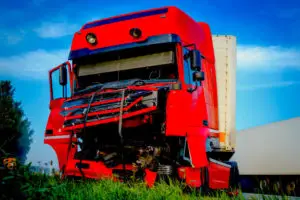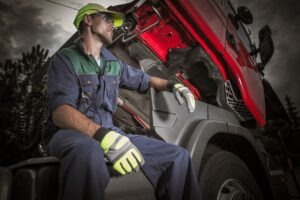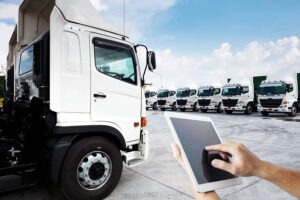
In this blog post, we summarize a range of facts about large trucks, and the accidents they cause, that you may not have known.
How Truck Accidents Happen
With so many trucks operating on American roadways, accidents are bound to happen. It is not uncommon to find a trucking company has a long-established compensation policy favoring faster speeds and longer drive times. To boost his or her bottom line, a trucker may be tempted to violate posted speed limits, and ignore federal regulations concerning maximum allowable hours on the road. Trucking companies can also be held accountable for truck accidents if they failed to:
- Properly train new hires
- Regularly inspect and repair the trucks in their fleet
- Provide adequate training
- Allow drivers to follow a realistic schedule


Expect More, Receive More: Legal Support That Feels Like Family
Danger on and off the Highways
Not so long ago, the only trucks commonly found in suburban neighborhoods were mail trucks, garbage trucks, and ice cream trucks. In today’s point and click world of online shopping, delivery trucks operate in our neighborhoods around-the-clock. When we factor in an ever-increasing fleet of school buses, our once quiet residential streets are fast becoming danger zones, especially for our children.
Delivery trucks from Amazon, FedEx, and United Parce Service (UPS) are now commonplace, and with the influx, we are seeing more and more accidents involving not only other motor vehicles but also with pedestrians and cyclists as well.
Like their colleagues who drive eighteen-wheelers across the country, the relentless pressure these drivers face to “beat the clock” can lead to reckless and careless driving habits.
Delivery truck accidents can easily happen when:
- In haste, the driver does not set the parking brake and the vehicle rolls either backward or forward;
- After missing an address, a driver backs up rather than driving around the block;
- A driver makes the mistake that many other drivers often make, such as failing to check blind spots, making inappropriate lane changes, or driving while distracted by a smartphone or on-board computer.
On the highways and interstate, truck accidents are possible when:
- The driver is traveling too fast for road conditions
- Exceeding the speed limit
- The driver is distracted
- The driver is fatigued
- The truck was not properly loaded and the cargo shifts
- The vehicle experiences an equipment failure
Some Insight
Trucks typically weigh 20-30 times more than a car, and it takes a big rig exponentially longer to come to a stop – thus, the force of the impact is fierce, and the extent of the injuries are widespread and often fatal.
“Ninety-seven percent of vehicle occupants killed in two-vehicle crashes involving a passenger vehicle and a large truck in 2017 were occupants of the passenger vehicles.” (Insurance Institute For Highway Safety)
That statistic results from the physical disparity between trucks and cars more so than the fault of either driver. No matter which vehicle’s driver caused the initial impact, the truck tends to cause the greater amount of damage, due to its sheer mass.
That is a problem because dangerous driving behaviors occur frequently on Florida roads, increasing the overall likelihood of a collision between a car and a truck. The Annual Uniform Traffic Safety Report from the Florida Department Of Highway Safety And Motor Vehicles shows us from 2018, law enforcement officials issued:
- 197,818 citations for careless driving
- 4,877 citations for speeding
- 73,167 citations for failure to yield
- 20,368 citations for following too close
- 60,855 citations for improper lane changes
Poor Choices, Bad Decisions, and Reckless Behavior
Truck accidents result from any number of potential causes. These include:
Driver Error
Truck drivers hold a commercial license, have extensive formal training, and are held to a higher standard of safety than other drivers. When truckers fail to follow the posted rules of the road, an/or the mandates of their professional license, every driver, pedestrian, or cyclist is in danger.
Poor Vehicle Maintenance
Commercial vehicles take a great deal of abuse and require thorough inspections and regular maintenance. Cracked windshields, old brakes, and worn out tires can spell disaster when traveling at high speed on a crowded highway.
Equipment Failure
Despite the high cost of a tricked-out truck, there are times when equipment will fail, or a component of a part will be found to be defective. In this instance, liability can be found with the manufacturer of the parts, the mechanic who installed the parts, the truck manufacturer, or the dealer.
Improper Cargo Loading
Like everything else, there is an acceptable way, a better way, and a wrong way to load cargo in a semi truck, tanker truck, or even a tow truck. Federal and state regulations are more than guidelines, they are specific requirements when it comes to the weight, size, length, width, and height of the loaded cargo. Additionally, there are detailed requirements for properly securing the load. Mistakes, negligence, or carelessness with the loading process can be life-changing.
It is becoming easier for truck owners and trucking companies to remotely monitor the condition of the vehicle from any internet-enabled computer. Innovative technology like aftermarket telematics and GPS tracking monitoring systems will go a long way toward:
- Ensuring compliance with mandated regulations
- Increasing safety for the driver and those on the roadways
- Monitoring the performance of the vehicle
- Increasing fleet security and safety.
A Truck by Any Other Name
When Henry Ford introduced the Model TT truck in 1917, man’s obsession with trucks began, and it continues today with no end in sight. Both Ford’s design and Chevy’s Model 490 only came equipped with a chassis. The truck bed itself was an aftermarket add on.
There is seemingly a truck for every purpose. For example:
- Boat haulage – Is a specialized low loader truck specifically designed to transport large prestigious watercraft
- Car carrier – Often double-decker vehicles used to move multiple cars from the manufacturers to dealerships across America
- Concrete truck – Is basically a concrete mixer on wheels
- Reefers – Are refrigerated vehicles to keep produce, meat and poultry fresh
- Crane truck – Is a truck fitted with a cable controlled crane
- Firetruck – Is equipped with hoses, sirens, automatic ladders, protective clothing, water, pumps, and a complete crew of firefighters
- Breakdown lorry – Also known as a tow truck is a vehicle used to move another vehicle from place to place
- Flatbed – Is a flat, level bed with no sides designed to move heavy cargo that does not need protection from the elements
- Livestock truck – A sturdy ventilated vehicle used to transport large animals
- Logging truck – Units specially designed to safely carry large quantities of lumber and logs
- Tanker – Used to carry oil, gas, liquid chemicals, water, fertilizers, and pesticides
- Dump truck – Also called a tipper truck moves sand gravel and demolition rubble
In a Class All Their Own
There are two-million tractor-trailers on the highways across America. Collectively they log an estimated 140 billion miles each year. Whether you call it a semi, a big rig, or an 18 wheeler, you can call it impressive they deliver 68 percent of all goods in the United States.
The anatomy of these behemoths is unlike any other. The truck and cab serve as a command center for long-distance drivers and can include:
- A sleeper berth
- Clothing storage area
- Thermoelectric coolers or travel refrigerators
- Electricity
- Bathroom
A semi-trailer is then attached to the back of the truck to tow cargo. With ten tractor wheels and eight trailer wheels, a tractor-trailer engine can be up to six times the size and weight of a car engine. A typical trailer is 53 feet long.
With 190,000 units sold each year, the top-selling semi is a Freightliner, followed closely by:
- Kenworth
- Peterbilt
- International
- Volvo
Some of the More Common Truck Accidents
Just as all trucks are not created equal, each accident is very different, and each comes with its own special set of consequences.
- Jackknife – Without proper control of a large truck, the trailer can shift, skid, and end up at a 90-degree angle, This type of accident often results in a multi-car pileup, and can cause severe injuries to passengers in every car in its path.
- Rear-end accident – If a truck driver is following too closely behind another vehicle, it is highly likely a rear-end accident will happen when the lead vehicle brakes suddenly or slows down. Physical damage is usually minimal when a rear-end accident is between two cars, but the tremendous weight of a large truck, combined with the weight of the cargo, can be devastating when a truck hits a car.
- Under-Ride – When a truck slams on the brakes, smaller vehicles behind the truck can become lodged under the rear truck trailer, often resulting in severe damage to the smaller vehicle and its passengers.
- Blind Spots – Large trucks have large blind spots called “no-zones.” When truckers are unable to detect when vehicles behind and beside them switch lanes, accidents are possible, probable, and can be fatal.
Historically, side-impact (T-bone) and head-on collisions cause the most property damage as well as the most severe physical injuries.
When Truck Accidents Happen
The immediate impact of a truck accident is frightening, confusing and painful, the long-term implications of physical impairments can be catastrophic and devastating. When a large commercial vehicle collides with a passenger car the injuries can last a lifetime. Some of these include:
- Traumatic brain injuries
- Paralysis
- Amputation
- Burns
- Vision problems
- Cognitive impairment
- Difficulties communicating
- Disfigurement
The Scope of the Trucking Industry
The trucking industry is vitally important to our economy. Large commercial vehicles will continue to transport needed manufactured goods, building supplies, and food and pharmaceutical products to communities throughout America. It is safe to say that, as a nation, life as we know it would come to a grinding halt within a few days if trucks were not able to deliver mail, food, medicine, and fuel. Accident projections tell us the annual cost of motor vehicle accidents will be $450 billion by the year 2025. Highway safety is everyone’s responsibility.
Proven Ways to Avoid Being the Victim of a Truck Accident
Commercial truck drivers and personal vehicle drivers alike all have a responsibility to each other to maintain safety standards and to obey the rules of the road. We all need to be more proactive and practice defensive driving when sharing the road with commercial trucks.
- Leave sufficient space between vehicles to maneuver and pass safely
- Never pass on the right-hand side
- Avoid making sudden stops
- Maintain a consistent speed
- Do not park directly behind a truck
- Always remember that a trucker may not be able to see you – if you can’t see the truck’s mirrors the driver, more than likely, can’t see you either
- Avoid distractions while driving
- Back off and allow trucks the space they need to merge in
- If possible, do not drive between two trucks
- Anticipate a truck will make wide turns
- Always use your turn signals
- Lower high-beam headlights while driving near a truck
- Wear a seatbelt
Additionally, unavoidable weather conditions adversely affect the safe driving ability of all vehicles on the road. Car drivers should adjust their speed accordingly when there is heavy rain, fog or smoke impeding visibility.
If you, or a family member, is feeling the effects of a truck accident, seek legal counsel from an experienced truck accident attorney.







